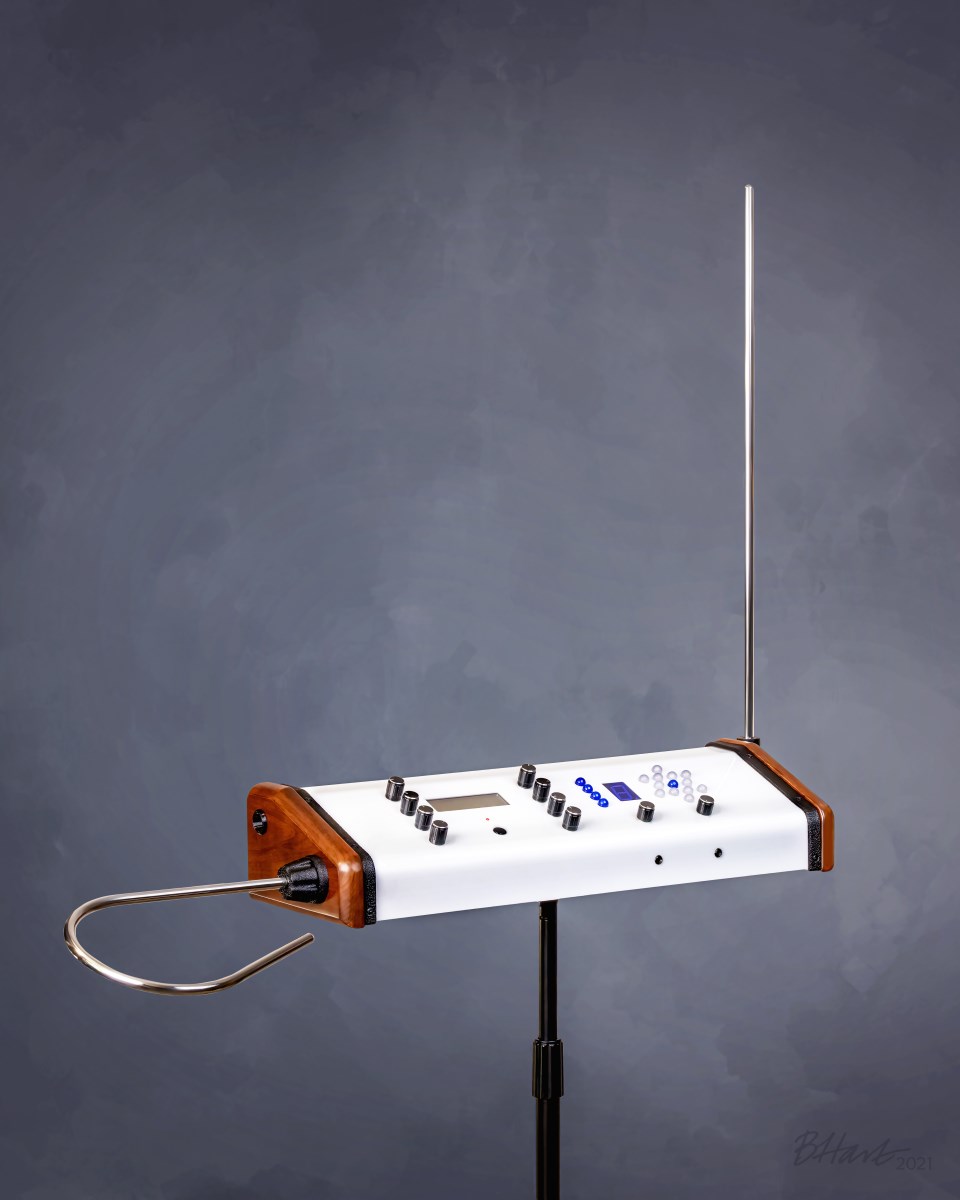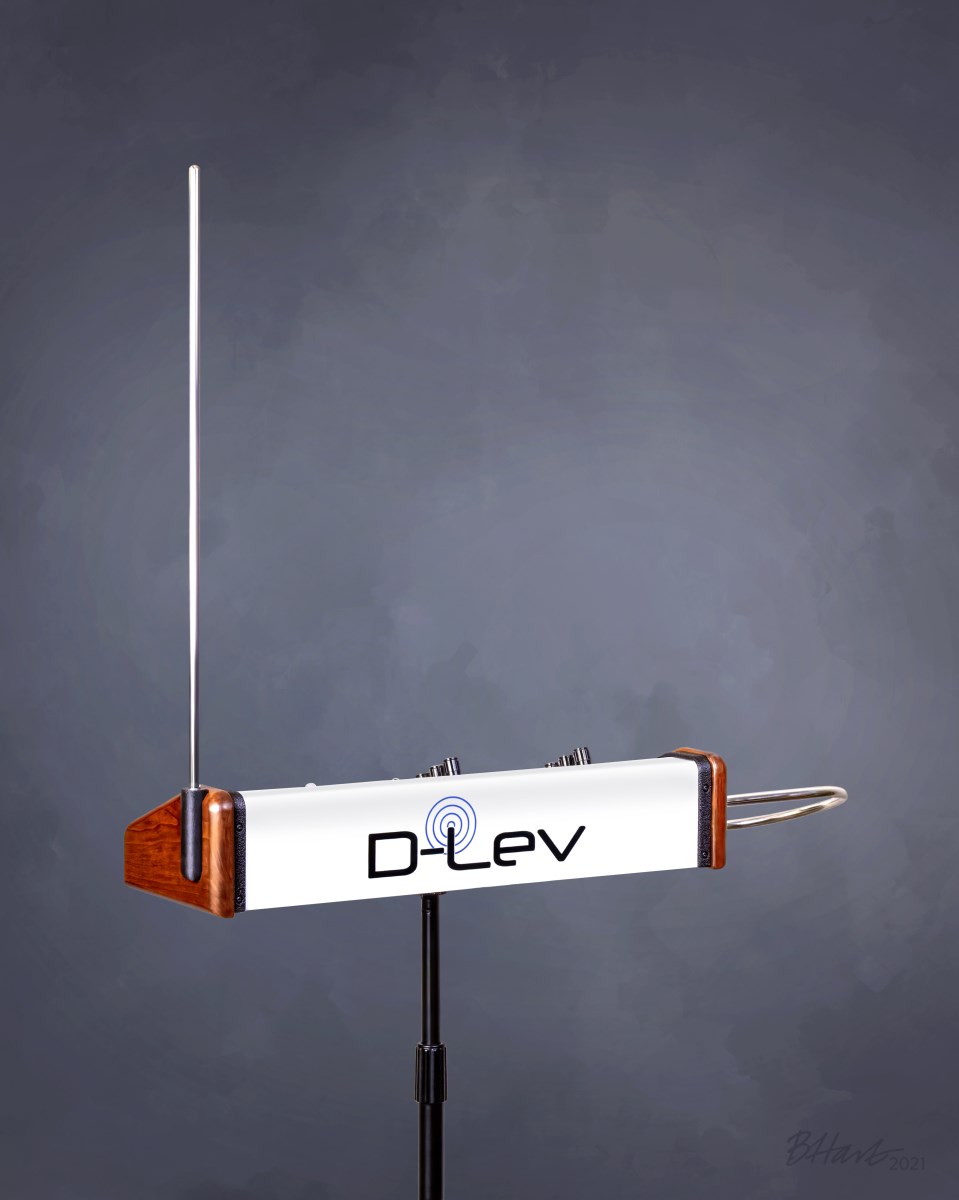D-Lev Model P3, Serial Number 0002
This is my latest D-Lev prototype built for Eric. It's basically a white version of the first red one finished a few weeks ago. I've tacked on a video demonstration at the end to prove that it works before I send it to him.


A long time ago I offered to build a finished theremin for Eric (Dewster) as a way of repaying him for sharing all of his secrets and letting me be the first early adopter of the D-Lev. At the time the idea was that his custom theremin would be the D-Lev "Tour" model which he had envisioned as road-worthy travel case with stowed antennas that would not just carry the theremin; it would be the theremin. But too many undefined design issues and my thinly veiled lack of interest in making something like that led to the whole concept being back-burnered.
Finally a couple years later after coming up with a sort-of replicable design I decided to just build up an extra and give him a second model of my P3 enclosure and electronics, whether he wanted it or not, and consider it a promise fulfilled. Now he will be receiving a pretend "production" model D-Lev, Serial Number 0002, out of what will be a total production run of two (maybe three) units. After building this white one I decided I want one for myself instead of the red model, so I might build a third and dump the red one.
Other than the white acrylic cover, the LED and display colors, and the type of wood this unit is identical to my first P3. The horizontal style of case is not my idea of stylish design, but I'm liking it more than the EW Pro/Claravox style of vertical cabinet with arms to hold the pitch antennas. The tuner is in a good location, the long case suits the antenna spacing, and the controls are in a perfect position.
After a fair amount of time with my red P3 and now this one, the only thing I really don't like is the fact that the high impedance end of the volume inductor is immediately beside the lower left encoder knob, which is the knob that selects the voice presets. If you turn this knob with your left hand, the audio is silenced (at least for me using conventional volume sensing) and you can't hear the voices. I have to turn this one knob with my right crossover hand to be able to hear the presets as I spin through them. I had considered reversing this coil but the IR sensor for muting is at the other end and having this in close proximity to the hi-Z end of the coil wouldn't be a good idea either. It's a minor thing, really, and otherwise I like the enclosure.
Below are a few photos of the interior and exterior.
This one that I built for Eric has cherry wood ends, a white acrylic panel with a black/blue vinyl logo, a black on white LCD, and blue and white tuner LEDs. I also put in the infrared touchless mute on the volume end of the case although when using reversed volume sensing as Eric does it may not be of much value and may get disabled. I also want to provide some sort of plate antennas (his preference) so he at least has something to start with or modify rather than build something from scratch:



This has a few slightly newer version boards than I used for my red version. The changes were minor, and both board sets are pretty well refined with no cuts or jumpers needed on any of the pcbs.

This is the output connector board that has a MIDI driver and the USB serial interface built in:

I had to add a series capacitor to the volume antenna to prevent the volume-side Digital Phase Lock Loop (DPLL) from going into search if you touch the antenna, which causes a sound even more annoying that the Etherwave's squealing sounds. The pitch and volume fields are so large on the D-Lev that touching antennas is a rare event, but not impossible if the parameters are set for close playing. I probably should do the same on the pitch side:

And finally this is a view of the whole interior:

I'll refrain from posting any more images because they are basically the same as posted previously for my red model.
I had other refinements in mind for this enclosure, but since this design won't be going anywhere I'll save them for my next D-Lev venture, whatever that might be. I have the urge to build an RCA-style case (a stand-off replica) with the D-Lev's multiple knobs and LCD panel somehow discreetly hidden, but I'm a little sketchy on how to do that right now. A traditional theremin cabinet is not very practical (I play seated) yet the urge is there to have an old-looking box pumping out some non-heterodyned timbres. A built-in amp and speaker might be nice since there would be enough room to store a set of encyclopedias and your bag lunch in a cabinet like that given the compact D-Lev electronics package.
And then there is the art-deco theremin case that I would like to build - something like an old radio with either wood veneers and grill cloth or the bakelite Fada-type with colored plastic shapes and red knobs. Theremins built inside stuffed beavers and crescent moons have already been done, so other areas need to be explored.
But I'm notoriously unproductive these days (age), and with too many things to do I'm going to be less involved with the D-Lev day-to-day as Eric takes over the circuit board design and kitting to start getting a few samples out there. I've put a few years (a lot less than Eric, a lot less) and several thousand dollars into this project because I am enthralled by it, and I think it's a pretty remarkable theremin that nobody knows about, yet. If you have the capability to build your own enclosure or you know someone that can help, I recommend that you consider buying the kit from Eric.
I think most of us who pay attention have a good idea what the Claravox is going to be, and even though I'm still on the list to get one I have no expectation that the D-Lev is going to lose the number one position in my lineup. The D-Lev really seems like a theremin designed just for me, because in many ways it is thanks to Eric's ability to turn feature requests into reality almost overnight.
Demonstration Video
Theremin videos always have to come with a pre-apology just to make it clear to the uninformed that we players aren't always tone deaf, and we can hear the bad notes too but we just can't do anything about them. It's a tough instrument to play, and blah blah blah...
That out of the way, I should explain this particular demo. Sometimes on a keyboard synth, or in this case the multi-talented D-Lev you twirl through the presets and find a sound that reminds you of a particular song in your present or past, and you start playing that song. It doesn't matter if the music genre isn't your usual preference, or even one that you might at a younger age have been embarrassed to be associated with, and such is the case here. Twang ain't my thang, but when I dialed in a particular female voice on the D-Lev I immediately started playing old Patsy Cline tunes. And Patti Page. I guess these get dangerously close to what might be called Classic Country, which I guess is a lot more palatable than the white hats and autotune of Contemporary Country. But good voices are timeless, and Patsy Cline, Patti Page, and Bing Crosby, are all great voices that somehow the D-Lev is able to pull off quite convincingly.
And if you're really (un)lucky, I may show you my Marty Robbins "Ghost Riders" sometime...
So here is a stab at Patsy Cline singing "Sweet Dreams" as rendered on the D-Lev, played over one of the few decent accompaniment tracks that I could buy to make it all YouTube legal:
[Update] I immediately received a notice during the upload that there is a copyright claim against this content - not for "Sweet Dreams" but for something called "She's Got You" which I've never heard of. I've disputed the claim because I bought the backing track and have permission to use it.

